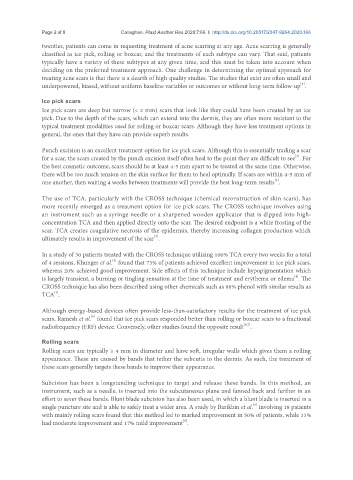Page 780 - Read Online
P. 780
Page 2 of 8 Callaghan. Plast Aesthet Res 2020;7:66 I http://dx.doi.org/10.20517/2347-9264.2020.166
twenties, patients can come in requesting treatment of acne scarring at any age. Acne scarring is generally
classified as ice pick, rolling or boxcar, and the treatments of each subtype can vary. That said, patients
typically have a variety of these subtypes at any given time, and this must be taken into account when
deciding on the preferred treatment approach. One challenge in determining the optimal approach for
treating acne scars is that there is a dearth of high-quality studies. The studies that exist are often small and
[1]
underpowered, biased, without uniform baseline variables or outcomes or without long-term follow-up .
Ice pick scars
Ice pick scars are deep but narrow (< 2 mm) scars that look like they could have been created by an ice
pick. Due to the depth of the scars, which can extend into the dermis, they are often more resistant to the
typical treatment modalities used for rolling or boxcar scars. Although they have less treatment options in
general, the ones that they have can provide superb results.
Punch excision is an excellent treatment option for ice pick scars. Although this is essentially trading a scar
[2]
for a scar, the scars created by the punch excision itself often heal to the point they are difficult to see . For
the best cosmetic outcome, scars should be at least 4-5 mm apart to be treated at the same time. Otherwise,
there will be too much tension on the skin surface for them to heal optimally. If scars are within 4-5 mm of
one another, then waiting 4 weeks between treatments will provide the best long-term results .
[3]
The use of TCA, particularly with the CROSS technique (chemical reconstruction of skin scars), has
more recently emerged as a treatment option for ice pick scars. The CROSS technique involves using
an instrument such as a syringe needle or a sharpened wooden applicator that is dipped into high-
concentration TCA and then applied directly onto the scar. The desired endpoint is a white frosting of the
scar. TCA creates coagulative necrosis of the epidermis, thereby increasing collagen production which
[2]
ultimately results in improvement of the scar .
In a study of 30 patients treated with the CROSS technique utilizing 100% TCA every two weeks for a total
[4]
of 4 sessions, Khunger et al. found that 73% of patients achieved excellent improvement in ice pick scars,
whereas 20% achieved good improvement. Side effects of this technique include hypopigmentation which
[4]
is largely transient, a burning or tingling sensation at the time of treatment and erythema or edema . The
CROSS technique has also been described using other chemicals such as 88% phenol with similar results as
[5]
TCA .
Although energy-based devices often provide less-than-satisfactory results for the treatment of ice pick
[6]
scars, Ramesh et al. found that ice pick scars responded better than rolling or boxcar scars to a fractional
[6,7]
radiofrequency (FRF) device. Conversely, other studies found the opposite result .
Rolling scars
Rolling scars are typically ≥ 4 mm in diameter and have soft, irregular walls which gives them a rolling
appearance. These are caused by bands that tether the subcutis to the dermis. As such, the treatment of
these scars generally targets these bands to improve their appearance.
Subcision has been a longstanding technique to target and release these bands. In this method, an
instrument, such as a needle, is inserted into the subcutaneous plane and fanned back and further in an
effort to sever these bands. Blunt blade subcision has also been used, in which a blunt blade is inserted in a
single puncture site and is able to safely treat a wider area. A study by Barikbin et al. involving 18 patients
[8]
with mainly rolling scars found that this method led to marked improvement in 50% of patients, while 33%
had moderate improvement and 17% mild improvement .
[8]

